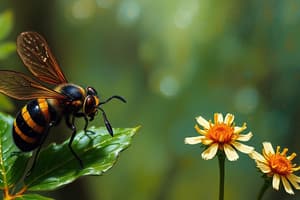Podcast
Questions and Answers
Match the following habitat types with their characteristics:
Match the following habitat types with their characteristics:
Terrestrial = Includes forests, grasslands, deserts Aquatic = Comprises freshwater and marine environments Urban = Human-modified landscapes affecting insect habitats Desert = Characterized by low moisture and extreme temperatures
Match the following insect roles with their functions:
Match the following insect roles with their functions:
Pollinators = Crucial for plant pollination Decomposers = Break down organic matter, recycling nutrients Predators = Control populations of other insects Prey = Serve as a food source for other animals
Match the following types of adaptations with their examples:
Match the following types of adaptations with their examples:
Morphological = Wings and camouflage Behavioral = Nesting habits and migratory patterns Physiological = Internal changes to survive drought Social = Cooperative behavior in ant colonies
Match the following concepts in population dynamics with their definitions:
Match the following concepts in population dynamics with their definitions:
Match the following types of insect interactions with their effects:
Match the following types of insect interactions with their effects:
Match the following impacts of insects on ecosystems with their descriptions:
Match the following impacts of insects on ecosystems with their descriptions:
Match the following anthropogenic effects with their consequences:
Match the following anthropogenic effects with their consequences:
Match the following conservation efforts with their goals:
Match the following conservation efforts with their goals:
Match the following types of insects with their roles in ecosystems:
Match the following types of insects with their roles in ecosystems:
Flashcards are hidden until you start studying
Study Notes
Insect Ecology
-
Definition: Insect ecology is the study of the relationships between insects and their environments, including interactions with other organisms, and how they adapt to their habitats.
-
Habitat Types:
- Terrestrial: Forests, grasslands, deserts, urban areas.
- Aquatic: Freshwater (streams, lakes) and marine environments.
-
Niche and Role:
- Pollinators: Many insects (bees, butterflies) are crucial for plant pollination.
- Decomposers: Beetles, ants, and termites break down organic matter, recycling nutrients.
- Predators/Prey: Insects play key roles in food webs, as both predators (e.g., ladybugs) and prey (e.g., caterpillars).
-
Adaptations:
- Morphological: Physical adaptations (e.g., wings, camouflage).
- Behavioral: Nesting habits, migratory patterns, social behavior in species like ants and bees.
-
Population Dynamics:
- Factors influencing populations include climate, food availability, predation, and disease.
- Concepts:
- Carrying capacity: Maximum population size an environment can sustain.
- Boom and bust cycles: Populations experiencing rapid growth followed by sharp declines.
-
Community Ecology:
- Insect interactions: Symbiosis (mutualism, parasitism, commensalism).
- Ecosystem engineers: Termites and ants that alter their environment (e.g., soil aeration).
-
Impact of Insects on Ecosystems:
- Biodiversity: Insects contribute to ecosystem diversity and resilience.
- Ecosystem services: Pest control, soil formation, pollination, and nutrient cycling.
-
Anthropogenic Effects:
- Habitat loss: Urbanization and agriculture reduce habitats.
- Pollution: Pesticides and chemicals can harm insect populations and diversity.
- Climate change: Alters habitats and food sources, impacting insect survival.
-
Conservation Efforts:
- Protecting habitats through reserves and sustainable practices.
- Promoting biodiversity by supporting insect-friendly environments.
- Research on insect populations and ecosystems for effective management strategies.
Insect Ecology Definition and Scope
- Insect ecology examines insect interactions with their environment, including other organisms and habitat adaptation.
- Study encompasses terrestrial (forests, grasslands, deserts, urban areas) and aquatic (freshwater, marine) habitats.
Insect Roles and Niches
- Insects are vital pollinators (bees, butterflies) for plant reproduction.
- Many act as decomposers (beetles, ants, termites), recycling nutrients.
- They function as both predators (ladybugs) and prey (caterpillars) within food webs.
Insect Adaptations
- Insects exhibit morphological adaptations (wings for flight, camouflage for protection).
- Behavioral adaptations encompass nesting, migration patterns, and complex social structures (ants, bees).
Insect Population Dynamics
- Population sizes are influenced by climate, food availability, predation pressure, and disease prevalence.
- Key concepts: carrying capacity (environmental limit to population size) and boom-and-bust cycles (rapid growth followed by decline).
Insect Community Ecology
- Insects interact through symbiosis (mutualism, parasitism, commensalism).
- Certain insects act as ecosystem engineers (termites, ants), modifying their surroundings (e.g., soil aeration).
Impact of Insects on Ecosystems
- Insects greatly contribute to biodiversity and ecosystem stability.
- They provide crucial ecosystem services: pest control, soil formation, pollination, nutrient cycling.
Anthropogenic Impacts on Insect Populations
- Habitat loss due to urbanization and agriculture negatively impacts insect populations.
- Pollution, especially from pesticides, threatens insect diversity and survival.
- Climate change alters habitats and food availability, affecting insect survival rates.
Insect Conservation Strategies
- Conservation efforts focus on habitat protection via reserves and sustainable practices.
- Supporting insect-friendly environments promotes biodiversity.
- Research on insect populations and ecosystems is crucial for developing effective management strategies.
Studying That Suits You
Use AI to generate personalized quizzes and flashcards to suit your learning preferences.




